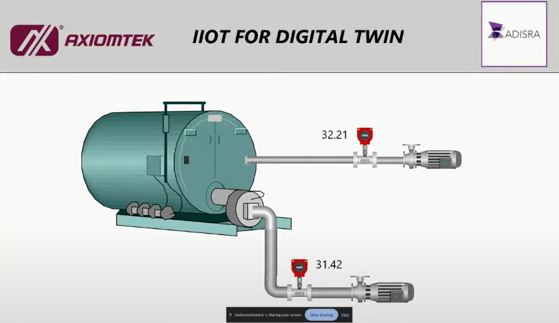
How does AI and IoT facilitate the Digital Twin modeling? How well the Digital Twin is able to help the industries in cost reduction?
Above the main topic in the discussion in the live session recently help by AIoTmission.
What exactly is the Digital Twin?
Imagine having an imaginary friend who’s exactly like you, knows everything you know, and does everything you do—but they live in a magical world inside a computer. That’s kind of what a digital twin is for things like machines or buildings! It’s a virtual copy that looks and behaves just like the real thing, and it helps us understand how the real thing works and how we can make it better. So, engineers and scientists use digital twins to explore ideas, test out changes, and even predict what might happen in the real world without having to actually touch or change the real thing. It’s like having a secret double that helps you understand and improve stuff without any real-life consequences!
In manufacturing, digital twins are like having a crystal ball that shows us exactly what’s happening inside our machines and processes, but in a virtual world. Here’s how they help optimize things:
Understanding Current State: Imagine you have a digital twin of a production line. It mirrors what’s happening in real-time, showing you every little detail of how machines are running and how materials are flowing. This deep understanding helps identify bottlenecks, inefficiencies, or areas for improvement.
Testing Changes: Let’s say you want to try a new production layout or adjust machine settings. Instead of making these changes in the real world and risking disruptions, you can test them out on the digital twin first. It’s like running a simulation to see how things would play out without any real-world consequences.
Predictive Insights: Digital twins can analyze historical data to predict future outcomes. For example, they can forecast machine failures based on patterns in sensor data. By knowing when a machine might break down, you can schedule maintenance proactively, minimizing downtime and maximizing productivity.
Optimizing Resources: With a digital twin, you can experiment with different scenarios to find the most efficient use of resources like energy, materials, and time. This might involve tweaking production schedules, adjusting inventory levels, or optimizing supply chain logistics to reduce waste and costs.
Continuous Improvement: Digital twins provide a platform for ongoing optimization. As you gather more data and learn from past experiences, you can fine-tune processes, iterate on designs, and drive continuous improvement across your manufacturing operations.
In essence, digital twins act as your virtual eyes and ears in the manufacturing world, helping you see what’s happening, predict what might happen next, and make smarter decisions to optimize processes and improve outcomes.


Remote IOT sernsor the RTD temperature sensors being monitor at the SCADA Station via the lora Transceiver the radio connection that provide up to 1.5KM of radius coverage. That ease our the integration of shop floor data collection without any hard wiring.

Temperature sensors data was collected at the Axiomtek IIoT edge gateway which is hosting the data over web API server. Data retrieval is done via the Adistra SCADA Server.
Supervisory Control and Data Acquisition (SCADA) software plays a crucial role in feeding data to digital twins by acting as a bridge between physical systems and virtual representations. Here’s how it works:
Data Acquisition: SCADA systems are designed to collect real-time data from various sensors, instruments, and control devices deployed across industrial processes. These sensors measure parameters such as temperature, pressure, flow rates, and energy consumption, among others.
Data Processing and Visualization: SCADA software processes the raw data collected from sensors, aggregates it, and presents it in a format that is easily understandable to operators and engineers. This processed data is typically displayed in the form of graphs, charts, and dashboards within the SCADA interface.
Data Transmission: Once the data is processed, SCADA systems transmit it to other software applications or platforms, including digital twins. This transmission can occur through various communication protocols such as OPC (Open Platform Communications), MQTT (Message Queuing Telemetry Transport), or RESTful APIs (Representational State Transfer Application Programming Interfaces).
Integration with Digital Twins: Digital twin platforms receive the data transmitted by SCADA systems and use it to update the virtual representations of physical assets and processes in real-time. This data includes information about the current state, performance, and operational parameters of the physical systems, enabling the digital twin to accurately reflect their behavior.
Feedback Loop: Digital twins may analyze the data received from SCADA systems to simulate different scenarios, predict future behavior, or optimize operations. Any insights or recommendations generated by the digital twin can be fed back to the SCADA system or directly to operators for action, creating a closed-loop feedback mechanism for continuous improvement.
In summary, SCADA software serves as a critical data source for digital twins by collecting, processing, and transmitting real-time data from physical systems, enabling virtual representations to accurately mirror their real-world counterparts and support data-driven decision-making and optimization efforts.
Lorem ipsum dolor sit amet, consectetur adipiscing elit. Ut elit tellus, luctus nec ullamcorper mattis, pulvinar dapibus leo.
To watch the session live, please click the link below:-
AIoTmission Sdn Bhd, established in 2022 as a subsidiary of Axiomtek (M) Sdn Bhd, is a leading provider of technological training and consultancy services specializing in Artificial Intelligence (AI) and Industrial Internet of Things (IIoT) solutions. Our mission is to drive the Fourth Industrial Revolution (IR4.0) and facilitate digital transformation across Southeast Asia, including Malaysia, Singapore, Indonesia, the Philippines, Thailand, Vietnam, and Myanmar. At AIoTmission, we are dedicated to advancing research and development in AI and IIoT technologies, with a focus on industrial applications such as sensors, gateways, wireless communications, machine learning, AI deep learning, and Big Data cloud solutions. Through collaboration with our valued clients and partners, we deliver innovative solutions tailored to industry needs, enhancing technological capabilities and operational efficiency.
